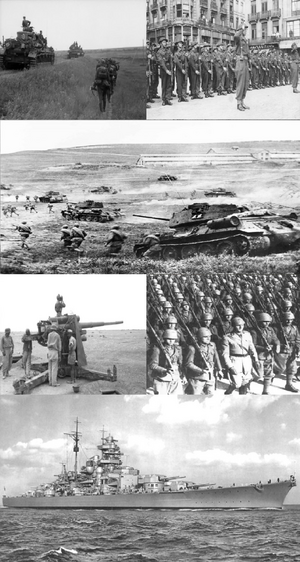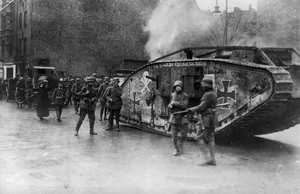Corentian Campaign (Sunalayan Second Great War)
This article is incomplete because it is pending further input from participants, or it is a work-in-progress by one author. Please comment on this article's talk page to share your input, comments and questions. Note: To contribute to this article, you may need to seek help from the author(s) of this page. |
| Corentian Campaign | |||||||
|---|---|---|---|---|---|---|---|
| Part of the Second Great War | |||||||
 From Left to Right: Englean Heer troops advancing into Damsmar, Rhodeve Protectorate Program soldiers, Libriran combined forces counter-attacking Damsmarian positions, Englean FlaK 36 in the Trident Desert, Damsmarian soldiers, and Kaiser class undergoing sea trials. | |||||||
| |||||||
| Belligerents | |||||||
| Commanders and leaders | |||||||
|
|
| ||||||
The Corentian Campaign of the Second Great War took place from ? Oct (?) 19?? to ? Aug(?) 194?. It included campaigns fought in Sunrisia, Librira, the Englean Kaiserreich, and Daredland. This campaign was fought between the Corentian forces of the Dronden Pact (Librira, the Englean Kaiserreich, Talvistova), non-Corentian forces of the Pact (Rhodevus, Aznazia), and the forces of the Core (Damsmar and the Frasian Federation).
Background
Damsmarian Empire
Englean Kaiserreich
Following what was seen as a victory in the Corentian Campaign of the First Great War, the Kaiserreich had focused throughout the following decades on further industrial and infrastructural improvements rather than military buildup. At this time, the Kaiserliche-Marine became the most powerful branch of the Englean GKSeK due to the Kaiserliche Heer lacking enough action in the First Great War to justify increases in funding. Following the war it was believed that the next major war involving the Kaiserreich would involve much more action at sea, rather than on the land in Corentia. This process in thinking allowed the Damsmarian Empire to grow in strength in comparison to the Kaiserreich, leaving the latter nation significantly susceptible to invasion.
In addition to this, the hurricane season of 193? was a particularly active one.
The decades following the First Great War saw the rise of hostile ideologies that threatened the stability of the monarchial government that the Kaiserreich had possessed since its inception in 875. Ideologies such as republicanism, socialism, communism, and fascism threatened to pull support from those suffering from the 1929 Economic Depression as it had done in many nations around the world. The Imperial Government attempted to produce new legislation to bring back support from these groups, but many failed to live up to expectations and instead brought more hostility from the lower classes.
This hostility was brought to a boiling point after the Stühshafen Incident of 1933, when soldiers of the Royal Sachsen Landwehr opened fire on protesting Frasian citizens after one soldier believed to hear a gunshot. This event marked the formal declaration of succession of the Frasian Federation from the Englean Kasierreich in 1933.
Frasian Federation
Librira
Talvistova
The Rhodeve Protectorate Program
The Rhodeve Protectorate Program (RPP) was created in 1937 between Rhodevus, Ispanza, Eubatu and Lylhorion, as a mutual protection and economic aid treaty between Rhodevus and the smaller nations in order to alleviate the continuing pain caused by the ongoing Great Recession.
Damsmarian Invasions
they failed
